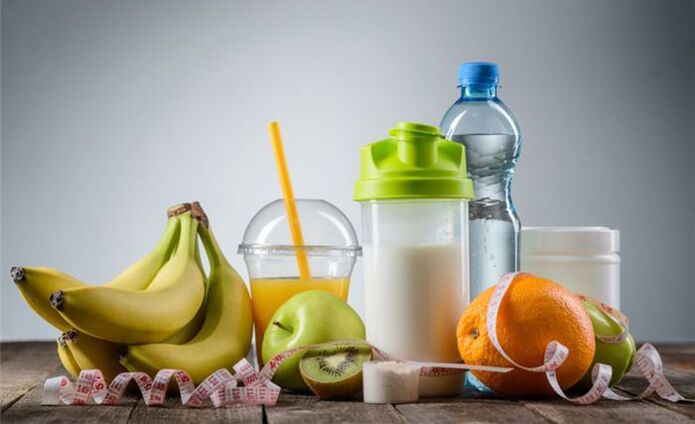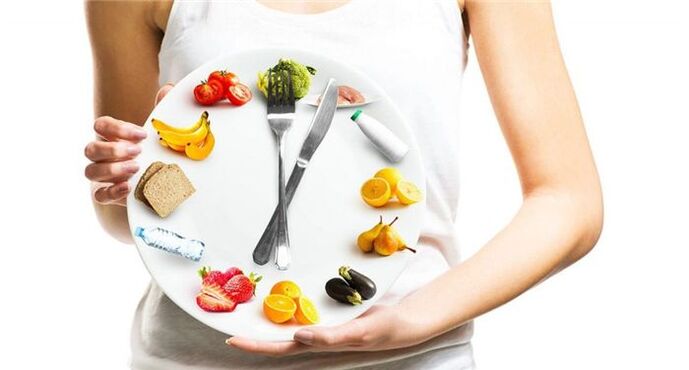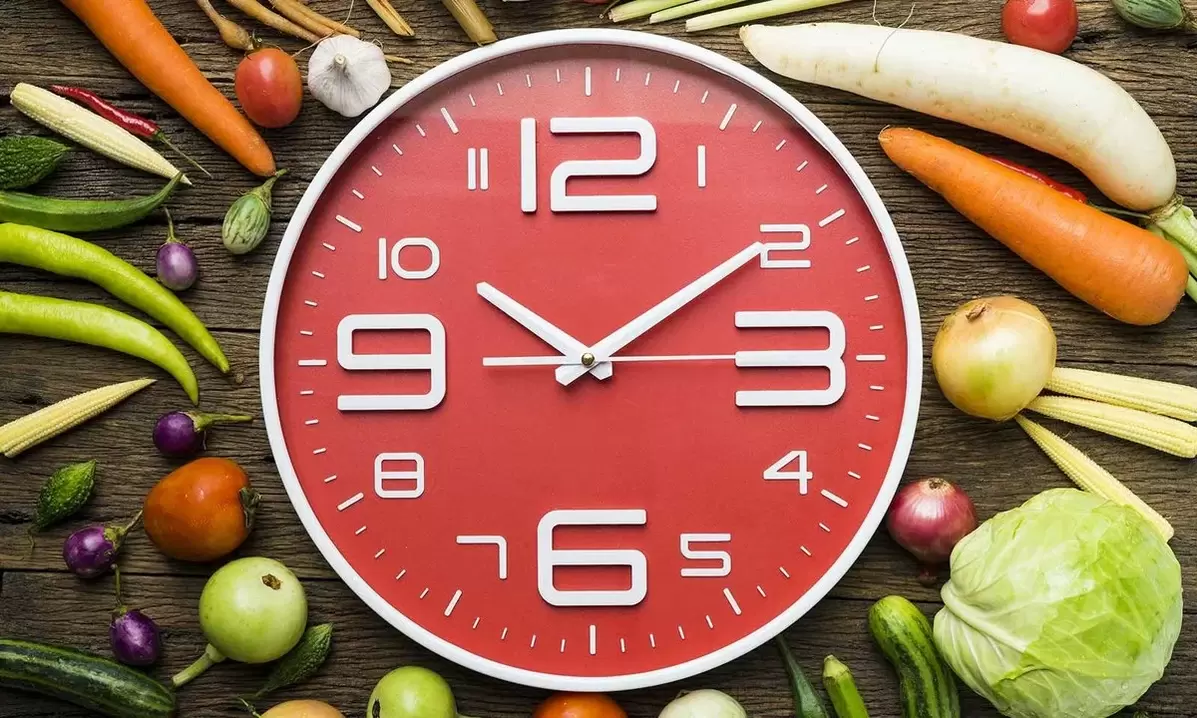
PP program
- Pay attention to the "Food Pyramid", according to which 40% of the dishes on the table should contain complex carbohydrates (this includes whole wheat bread, all types of cereals except semolina, as well as cereals) and 35% fresh and steamed orBaked vegetables and fruits, 20% healthy protein (lean meats, any type of poultry and fish, cultured milks and dairy products). The remaining 5% may come from fat and sugar.
- Combine meat with vegetables and fruits.
- If you really want it, you can have something sweet. But do not exceed the allowed daily limit of sugary products - 5 teaspoons. Even better, use honey instead of sugar. All desserts should be consumed only during the first half of the day to allow time to burn the calories received before the evening.
- Make sure your body gets enough protein (a person needs at least 100-150 grams per day). Protein is a building material that renews cells and maintains muscle performance. If you give up meat and poultry, you should eat plant-based protein, which is found in large amounts in beans, nuts, and soybeans.
- Avoid processed foods, fast food, sauces, and canned foods. Even ketchup has a lot of added sugar and salt.
expiration date
What kind of nutrition can be called correct?
How to create this week's menu
- Breakfast should be rich in carbohydrates;
- Dinner should be high in carbohydrates;
- Every meal should include foods containing fiber (vegetables, fruits, bran);
- If you want to eat something sweet, only eat it during the first half of the day;
- Proper distribution of calories is important.
How to Create a Weight Loss Meal Plan
Meal plans for "early risers" (e. g. , people who wake up at 6: 00 a. m. and go to bed at 10: 00 p. m. )
- Have breakfast at 7: 00 am
- At 10 o'clock, enjoy the second light breakfast
- Go to have lunch at 13 o'clock
- Afternoon tea time at 16: 00
- Have dinner at 19 o'clock
Eating habits of "night owls" (people who wake up after 9 a. m. and go to bed around 00 a. m. )
- Breakfast at 10 a. m.
- 13: 00 Lunch time
- It’s time for lunch at 15: 00
- Go for afternoon tea at 17: 00
- It’s time for dinner at 20 o’clock
Main recommendations
- You should have breakfast one hour after getting up
- Drink 250 ml of warm boiled water on an empty stomach in the morning.
- Allow 2-3 hours between meals
- Eat dinner early or no later than two hours before bed
What's important when creating a menu
- When planning your weekly menu, prepare a grocery shopping list right away. and decide immediately what to cook on which day. For example, on certain days, chicken and fish should be included. One day, you should have a light green salad for dinner, a hearty steak for lunch, etc.
- Even if you don't feel hungry, you shouldn't skip breakfast. Every breakfast should be balanced and nutritious - 50% of your daily intake of carbohydrates, 30% of protein, and 20% of fat.
- Dinner should be protein-based. For example, low-fat cottage cheese, grilled chicken, or steamed fish.
- An afternoon snack and a second breakfast are appropriate and balanced snacks between main meals. But they shouldn't turn into a full meal. Prepare fresh fruits as snacks (you can have a banana, 150-200 grams of grapes, a large apple), fresh or cooked vegetables (cabbage, tomatoes, carrots, radishes, etc. ), dried fruits or nuts (the latter should be without saltand not in large quantities). More than 30 grams per dose).
- When counting calories, subtract the calories burned during physical activity. For example, if you're walking around the city all day or planning a long trail ride, increase what you eat that day. Plan to eat a moderate amount of carbohydrates and protein, and eat a hearty breakfast before heading out.
- Drink regular drinking water - do not drink cold or boiling water (it cleans the gastrointestinal tract and starts metabolic processes). Green tea is good for those who want to lose weight (it speeds up metabolism, replenishes the body's needs for antioxidants and perfectly suppresses appetite).
- You can drink coffee, but only high-calorie coffee (latte or cappuccino) before lunch.
Misunderstandings about weight loss
- Breakdown of sweets and starchy foods (they should not be completely excluded, but intake should be watched to avoid violating daily calorie intake standards).
- Fried and smoked. You can perform this type of heat treatment on food if you fry it over an open flame without using oil and smoke it naturally for no more than 20 minutes (without using artificial smoke).
- Prefer raw vegetables and fruits over cooked and baked foods, and try to eat a variety of green vegetables.
- The dinner was sumptuous and the portions were large. When boiling or stewing meat or fish, be sure to add a serving of fresh vegetables (for example, 200 grams of boiled beef plus a fresh cucumber).
- Drink alcohol regularly. It should be avoided as it is high in calories and can cause intense hunger pangs.
- You should not drink water while eating. The same goes for tea or juice. Make a cup of tea only one hour before and half an hour after a meal.
- Be careful with salt, seasonings and sauces. All of these can greatly stimulate appetite and may lead to irregular eating and overeating.
- You shouldn't skip meals. Carry a bag of nuts, lemonade or a handful of raisins with you. This way you can curb your appetite and avoid overeating during delayed meals.
Sample menu of the week
first day
the next day
The third day
The fourth day
fifth day
The sixth day
seventh day
How to start eating right
- Expect to instantly improve your health and revolutionize your eating preferences and habits;
- Focus on multiple complex tasks simultaneously;
- Immediately give up all daily food;
- to elevate the harmony of diet to an end in itself and to subordinate the whole way of life to it;
- Focusing on thoughts about food can better direct the energy of your thoughts in another useful and important direction.
Why you need to eat right
Choose rules for eating that day

- It’s better to start eating smaller meals more frequently (not 3, but 4-6).
- Don't eat too much before going to bed.
- Include vegetables with every meal.
- Drink more boiled water.
- Reduce the amount of simple carbohydrates.
Start your day with a delicious and healthy breakfast

How to choose a healthy lunch
- The meal starts with soup;
- Drink hot drinks (except cold drinks);
- The interval between lunch and the previous meal should be at least 2-3 hours;
- It helps to balance a hearty lunch with a light dinner.
What's the best thing to have for dinner?
How many calories and minerals should the body absorb?
What foods should you avoid when developing a healthy diet?

- Baked goods, breads and wheat breads rich in yeast and containing additives (it is correct to give preference to yeast-free whole wheat and rye);
- candy;
- sausage products;
- Mayonnaise and sauces based on it;
- canned meat and fish;
- bacon and bacon dishes;
- yolk;
- Foods high in animal fat;
- Alcohol;
- Fast food, semi-finished products;
- Carbonated drinks, especially sweetened drinks, that contain dyes and flavorings.
Example of correct menu of the day
- For breakfast, porridge with buckwheat and eggs, natural cocoa as a drink, and a fresh apple or orange should be added;
- Lunch - kimchi soup, steamed, boiled or grilled chicken without fat, preferably fish fillet, a piece of rye or rye bread, green tea with honey or lemon;
- For an afternoon snack, you can have cottage cheese and fresh berries or fruit;
- A good dinner should consist of some lean meat (uncooked) and vegetables.
weekend
- Breakfast includes oatmeal and baked apples. You should use tea as a drink. It is important to understand that sugar should not be added to tea. If you want to sweeten your drink, honey is recommended.
- Second breakfast - yogurt and banana.
- For lunch, you can prepare chicken soup with vegetables. Experts recommend choosing fish as a second course. Salad - vinaigrette. The drink is candied fruit.
- As an afternoon snack, you can have yogurt and add nuts. You can choose dried fruits instead.
- For dinner, a ham and vegetable stew is a good choice. The drink is tea.
What to do if you don’t have enough time to cook
















































































